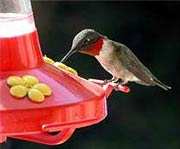
© Lee Karney USFWS |
Specialty Eaters
Hummingbirds specialize in eating nectar, evident by elongated bills ideal for probing tubular flowers. Though bills may vary slightly in size and shape, each protects a long and sensitive forked tongue, which a hummingbird uses to lick its nectar source -- whether a flower or a feeder -- anywhere from 3 to 13 times a second. The fork forms a trough that draws the nectar up by capillary action. Hummingbirds depend on the sugar-rich nectar for up to 90 percent of their diet; the rest is made up of insects and pollen that provide essential protein. |
|
Feeder Facts
Maintaining a backyard hummingbird feeder can help provide the birds with nectar critical to their survival, especially during the fall when they need to double their body mass before migration. (Contrary to a common fear the extra food won't stop a hummer from migrating south when it's time for it to go.) Follow these steps to ensure your yard is a safe and nutritious stopover for hummingbirds:
- Instead of one large feeder, hang several smaller ones in different locations. Keep the feeders far enough apart that the hummers cannot see one another; this will prevent one bird from dominating the rest.
- Fill the feeders with sugar water, made by combining four parts hot water to one part white sugar, boiled for one to two minutes. NEVER use honey, which promotes the growth of harmful bacteria, or artificial sweeteners. Also avoid red food coloring.
 |
| © Bruce Reid Audubon Mississippi |
- Hang your feeders in the shade to discourage fermentation and spoilage of the sugar solution.
- Be sure to change the sugar water regularly - before it gets cloudy, or about twice a week in warm weather.
- Clean the feeders with a solution of one part white vinegar to four parts water about once a week. If your feeder has become dirty, try adding some grains of dry rice to the vinegar solution and shake vigorously. The grains act as a good abrasive. Rinse your feeder well with warm water three times before refilling with sugar solution.
- Browse your local birding listservs to find out when the first hummingbirds sightings occur each spring, and aim to have your feeders up a couple of weeks before that. In the fall, keep your feeders up for two weeks after you see the last bird using it.
CLICK HERE to purchase Hummingbird Feeders and Accessories
Credits to National Audubon Society |